

Image Source - Canva
Embarking to sell your jewelry is often a journey filled with mixed emotions. A beloved piece of jewelry can embody precious memories and personal history, which usually adds additional layers of value beyond the material. It is essential to honor these emotions and assess whether the timing is right to part with such treasures.
Reflecting on sentimental resonance can offer a compass; if the item symbolizes significant life passages or relationships, such intrinsic value might decide to sell more complex. Carefully weighing these factors before looking for a jewelry buyer can aid in reaching a decision that aligns with both heart and mind.
Determining the value of jewelry can feel like navigating through an intricate labyrinth laden with tangible and intangible elements. Expert appraisers will examine the piece’s provenance, its components’ rarity and desirability, its condition, and current fashion trends in the context of historical significance. Beyond personal assessments, market factors like the purity of gold, the quality and carat of gemstones, and the intricacies of craftsmanship all play a part. Sellers should be vigilant in obtaining a credible appraisal, a pivotal reference for realistic expectations and honest transactions.
The enchanting world of jewelry is inherently connected to the erratic nature of commodity markets. The values of gold, silver, diamonds, and gemstones ebb and flow with global economic health, currency fluctuations, and consumer demand. One must stay informed of these changing tides to better anticipate when to sell and at what price. Going beyond one’s immediate network and tapping into industry insights provides clarity. Investopedia’s valuable online resource elaborates on these market dynamics, offering a broader view of how precious metals and gemstone valuations are derived and aiding jewelry owners in making enlightened decisions.
While navigating the intricate process of selling jewelry, establishing a symbiotic relationship with a reputable buyer is paramount. Objective credentials are necessary — licensure, affiliations with industry associations, and a solid history of ethical conduct set the foundation for trust. Sellers should delve into buyers’ past dealings through reviews and testimonials. An honest buyer will encourage queries and offer straightforward explanations surrounding their valuation methods and buying process, ensuring a clear, mutual understanding throughout the transaction.
Preparation is vital for showcasing jewelry in its utmost splendor. Entrusting the cleaning and possible refurbishment to professionals can return the piece to its original luster, potentially augmenting its appeal. Rich documentation acts as your artifact’s passport for the selling journey, signaling authenticity and care. The presence of certifications, particularly for diamonds and other valuable stones, receipts, and any appraisals, will reassure prospective buyers and significantly uplift the final valuation.
The digital revolution has broadened the horizons for selling possessions such as jewelry. An online presence allows for global reach and accessing niches that appreciate the unique nature of each piece. E-commerce platforms often enable rapid transactions, though they require due diligence to ensure safe and fair dealings. Conversely, while narrower in the audience, in-person sales allow for immediate verification of condition and authenticity and deep, engaging storytelling. One should weigh the convenience and reach of online selling against the tactile assurance and personal engagement of a physical venue.
Mastery over the arts of communication and bargaining often spells success in selling jewelry at favorable prices. Sellers must be ready to eloquently express their piece’s history, significance, and value, as storytelling can captivate and persuade buyers. Familiarizing oneself with the jewelry’s attributes and current market values cements a position of strength in negotiations. Nonetheless, engaging with empathy is wise, recognizing that every purchaser comes with unique motivations and limits. Being resolute yet flexible can lead to a satisfactory deal for both parties.
Completing a jewelry sale may not end the seller’s journey. The intricacies of financial and legal obligation await, manifesting as potential tax considerations such as capital gains and the necessity for a formalized, legal documentation of the sale. Sellers must proactively understand their responsibilities, consulting a tax professional to navigate any implications. Detailed records and transparent transactions form the backbone of a legally sound and financially wise sale.
If the decision to part with jewelry does not sit well, or if the sale does not align with your valuations, consider alternative routes to preserve and honor the legacy of your cherished pieces. Repurposing allows for rejuvenating its elements into new items of adornment, extending the life and story of the jewelry in the form of a modern heirloom. Alternatively, displaying the piece in a museum or donating to a charity related to the gemstone’s origin or history can ensure its tale and beauty continue to inspire. Such a transition can imbue your treasured items with continued purpose and significance beyond personal possession.
When it comes to honoring the memory of loved ones, many people choose traditional tributes…
Loft conversions are a fantastic way to add extra space and value to your home…
Getting the right gift for your high-value clients can foster a lasting relationship and positive…
Cyrus Nikou stands as a distinguished entrepreneur and philanthropist, renowned for his strategic prowess in…
Biometric security is gaining attention as concerns about digital privacy continue to grow worldwide. Momentarily,…
Parker Scott is the son of Kimberly Anne Scott, Eminem's ex-wife. Unlike his half-sister Hailie…